We all love big fluffy gluten free muffins, but how do you know the flour blend you have on hand will yield the best results? I decided to test four gluten free flour blends in my gluten free muffin base recipe to see how they would perform.
This post may contain affiliate links. Please read our Disclosure Policy.
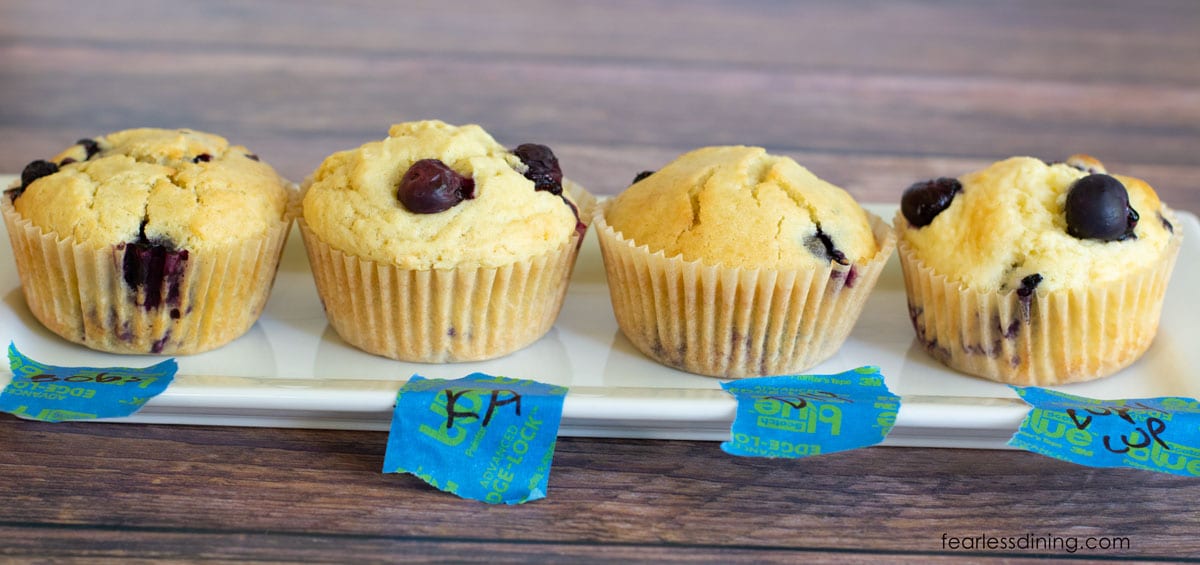
If you are gluten free, you may have noticed that gluten free baking can be trickier without traditional wheat flour. There are lots of gluten free flour blends on the market. But with so many options available at many different price points, it can be difficult to know which blends are worth your time and money.
I decided to test four different gluten free flour blends I had on hand to see how they compare. I ran this test by baking the same muffin recipe using each flour blend, including my custom DIY Gluten Free Flour Blend. I compare each muffin’s texture, flavor, and overall quality to help you determine which gluten-free flour blends to use.
So, whether you’re a seasoned gluten free baker or just starting out, read on to find out which flour blends make the best gluten free muffins!
If you love muffins as much as we do, check out my incredible Gluten Free Muffins Recipes. If you want to learn more about how gluten free flour blends differ, check out my guide to why flour blends vary so much.
Test Parameters:
- I used the same recipe with all flour blends with no variations, so I compared apples to apples with every blend. My gluten free muffin base recipe is perfect for this test because you can add any fruit or mix in!
- Although I created this gluten free muffin test using butter, you can swap dairy-free butter or oil to make this recipe dairy-free.
- I only used gluten free flour blends readily available at most grocery stores, so you do not have to order a fancy blend.
Read my gluten-free flour blend guide for more information on what gluten free flour is best for what types of recipes. You can also read my article on gluten free flour blend weights. I list what a cup of each blend actually weighs in grams.
The Gluten Free Blends Tested:
As I mentioned above, it was important to me to use easy-to-find gluten-free flour blends. I didn’t want readers to have to try to find and order a blend. These flour blends are available in most grocery stores.
- Bob’s Red Mill 1:1
- King Arthur Measure for Measure
- Cup4Cup
- My DIY Gluten Free Flour Blend (A gum-free gluten free flour blend for those who can not eat xanthan or guar gum.)
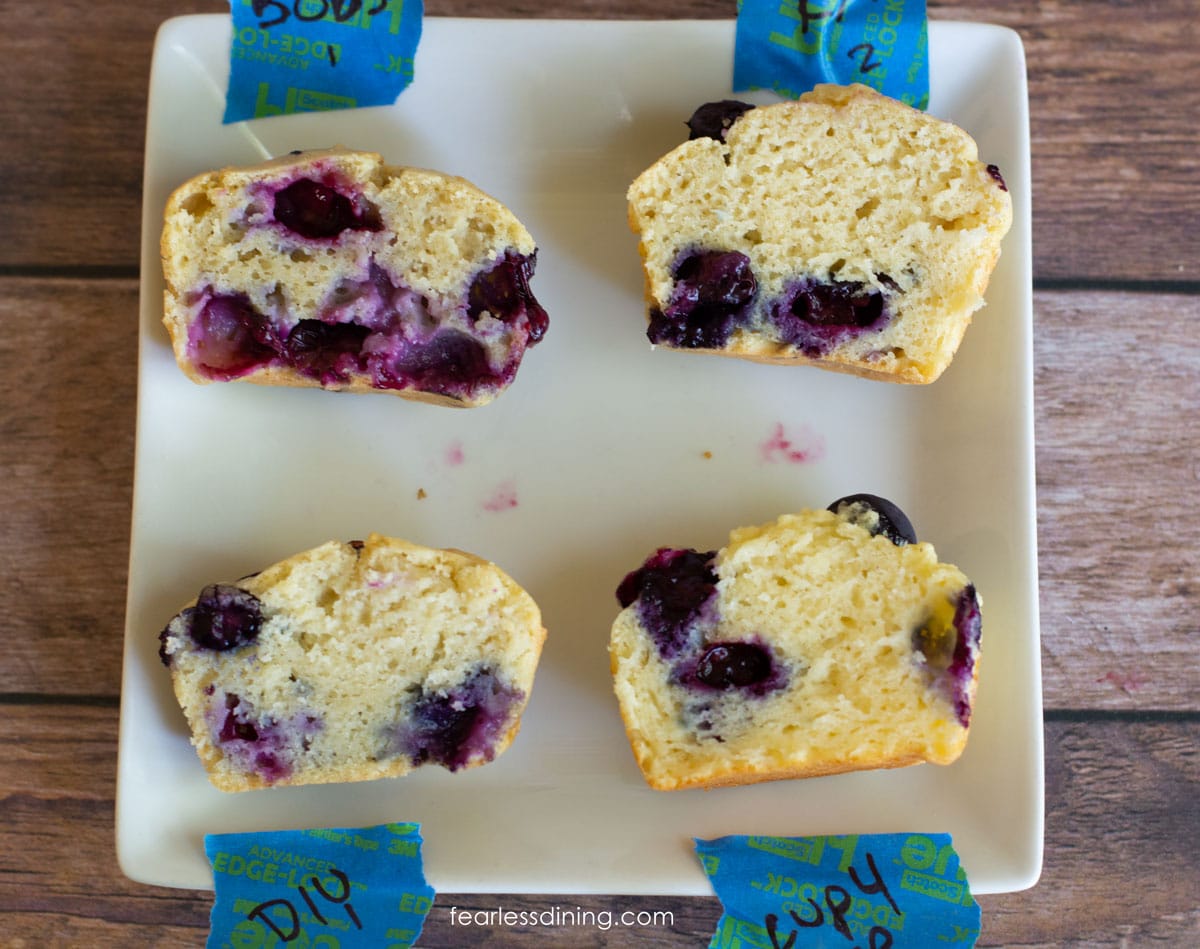
The Results:
I used the same muffin recipe for every blend, regardless of the consistency of the batter.
Each test used the following ingredients:
- 1 1/2 cups of the tested gluten free flour blend – I used the same cup measurements and weighed that for gram measurements. I did it this way because most of my readers do not own a digital scale.
- 1/2 cup sugar
- 1 1/2 teaspoons aluminum-free baking powder
- 1/8 teaspoon salt
- 2 large eggs
- 6 tablespoons unsalted
- 1 cup almond milk
- 1 teaspoon pure vanilla extract
All of the flour blends worked well, and the muffins tasted great. The main differences that I found were in the texture of the muffins and the amount of liquid to flour needed for success. This is due to differences in starch-to-grain ratios between gluten-free flour blends.
One interesting note with every blend: the muffins rose while baking and fell a little when they were cooling. I see this a lot when I bake muffins.
- Bob’s Red Mill 1:1 – Bob’s Red Mill 1:1 was good, though the muffins were gummier/chewier than the others. This could be due to the batter being runnier than the others. I recommend adding 2-3 tablespoons of additional flour if you use this blend to make this muffin recipe.
- King Arthur Measure for Measure – The King Arthur muffins rose nicely and were one of our favorites. I do not recommend any changes to the recipe. Note they had a slight grittiness, which I don’t often see when using this blend. Let the batter sit before baking for 10 minutes to fix the grittiness problem so the rice flour can soften more. These muffins rose well and were almost cake-like in fluffiness.
- Cup4Cup – Cup4Cup was also a great blend for this muffin recipe. Note for those who are dairy-free: this blend contains dried milk powder. The Cup4Cup muffins were a little more golden in color due to the dried milk powder in the blend. These muffins rose well and stayed almost cake-like in fluffiness.
- My DIY Gluten Free Flour Blend – My blend performed well and had good taste and texture, but I feel the muffins made with my blend would have turned out even better if an additional 2-3 tablespoons of flour had been added. The batter was a little runny compared to the King Arthur and Cup4Cup batter.
Check out my favorite Muffin Baking Tools and find some new favorites.
Tips For Sucess
1. Never use a stand or electric mixer to make gluten free muffins. Your muffins will turn out dense.
2. For a dome top, bake the muffins for the first 5-6 minutes at 425º F, then turn the oven temperature down to 350º F.
3. Use parchment paper muffin liners. Your muffins will not stick to the papers, and you will get to eat more of the muffins! Win-win!
For more muffin baking tips, read my Gluten Free Muffins Troubleshooting Guide.
Step-By-Step Photos and Directions:
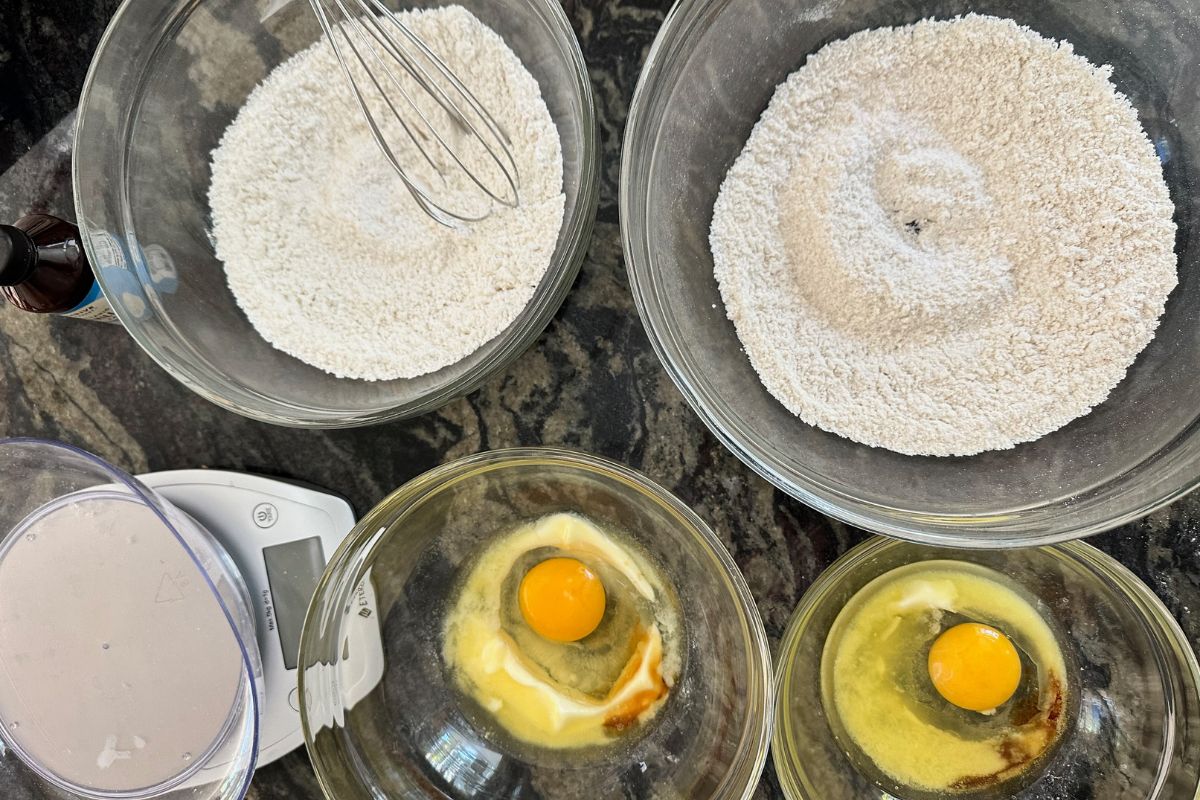
Step 1: I ran this flour blend recipe testing in two half batches at a time. The first step is to add the dry ingredients, including the flour, salt, baking powder, and sugar, to a large mixing bowl and whisk to blend them.
Step 2: In a smaller
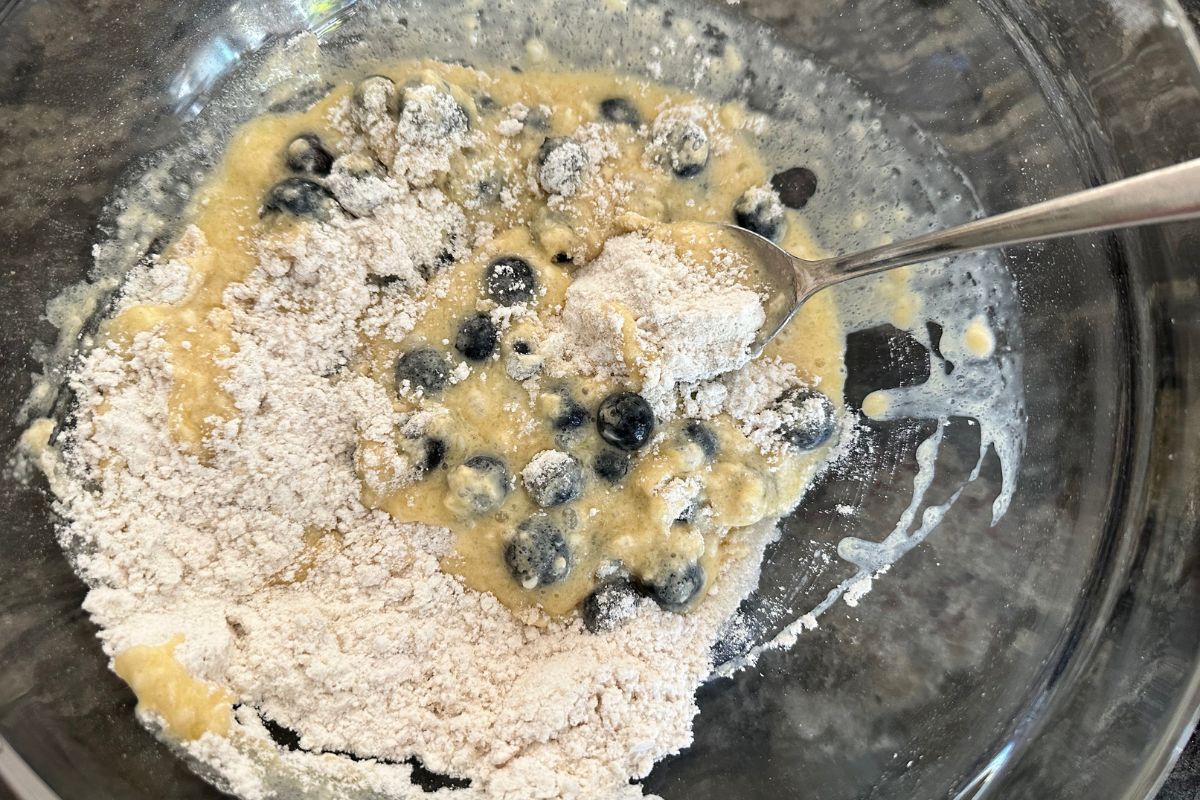
Step 3: Pour the wet ingredients into the dry ingredients. Mix them until they are just barely mixed. It is crucial not to overmix your batter when making gluten-free muffins.
Email This Recipe To Me!
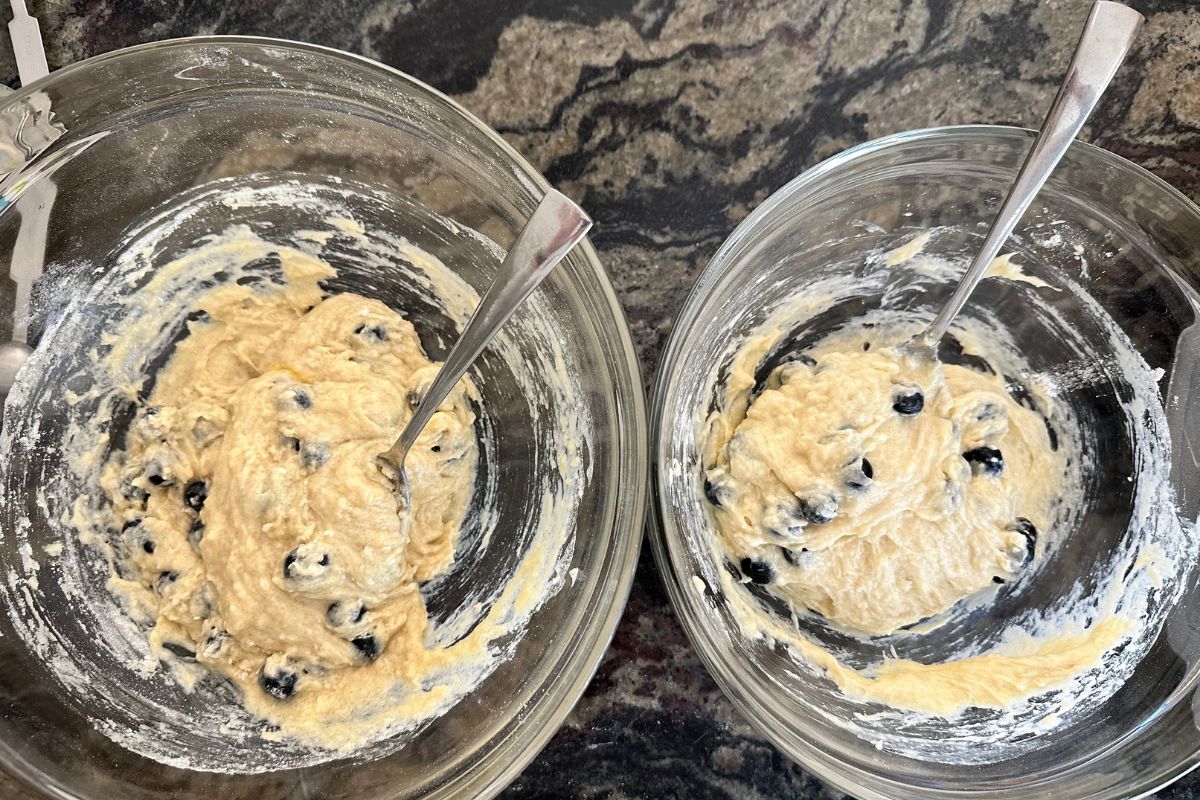
Step 4: Here are photos of the King Arthur (right) and Cup4Cup (left) muffin batter.
📢 Sandi says: Every gluten-free flour blend has a different starch-to-grain ratio. The brand of gluten-free flour you use will affect the moisture of the batter. If your cake batter is too runny, add more flour, and if it is too thick, add more liquids.
Read Why Gluten-Free Flour Blends Vary to learn more about this.
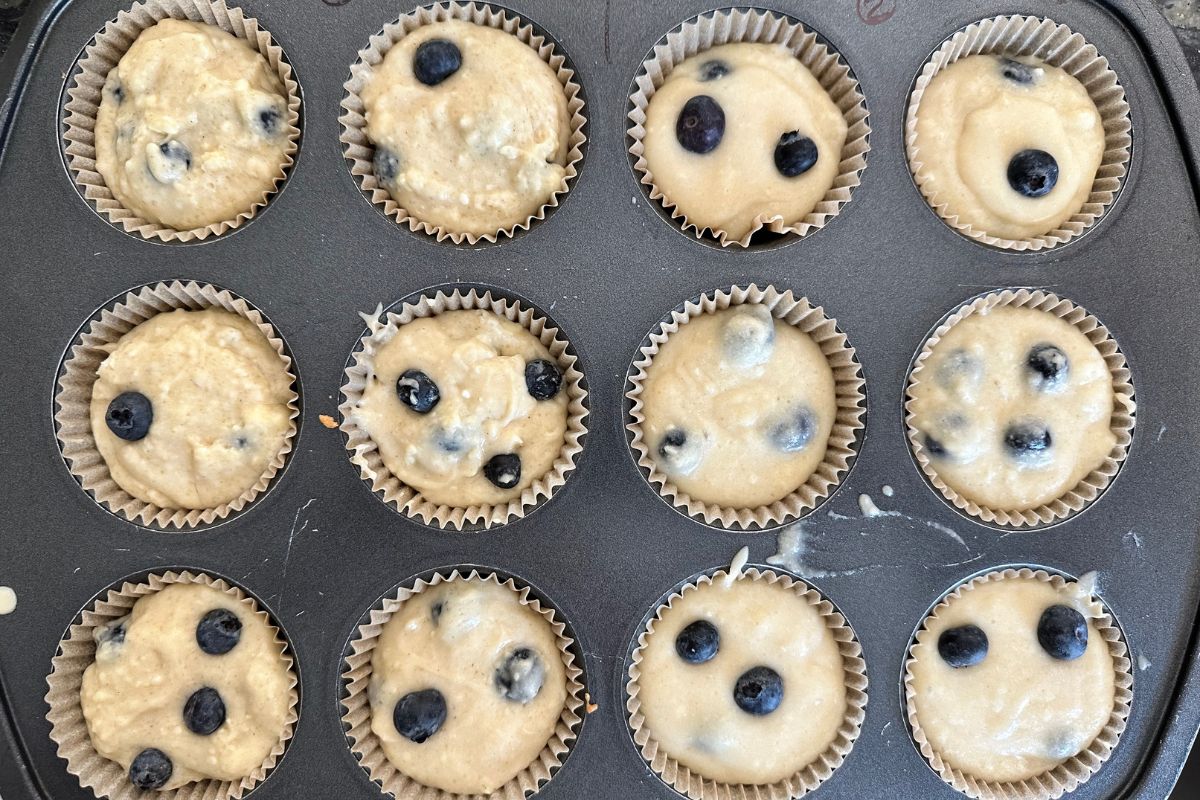
Step 5: Line a muffin tin with muffin liners and fill each 3/4 full gluten free muffin batter. Add a few blueberries if you notice any muffins with fewer blueberries.
Step 6: Bake the muffins at 425º F for 5 minutes, then turn down the oven to 350º F. Do not open the oven door while the muffins are baking. Bake the muffins for 20-25 minutes additional time.
🔑 Sandi says: Baking time can vary depending on the flour blend you use, the material of the muffin pan, and the size of the muffin pan you use.
The Cup4Cup baked a little quicker than the King Arthur in that test round.
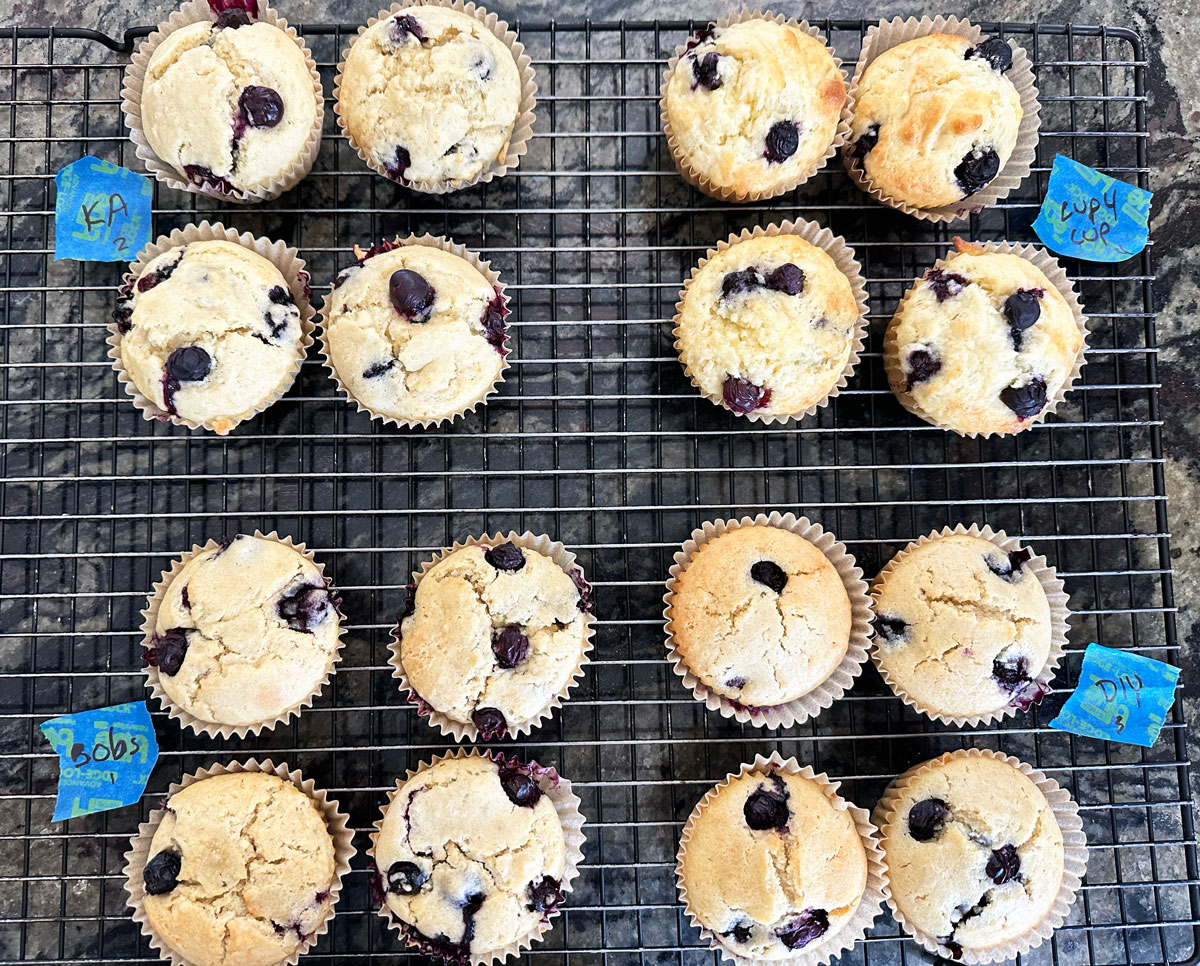
Step 7: Remove the muffins from the tin and place them onto a cooling rack.
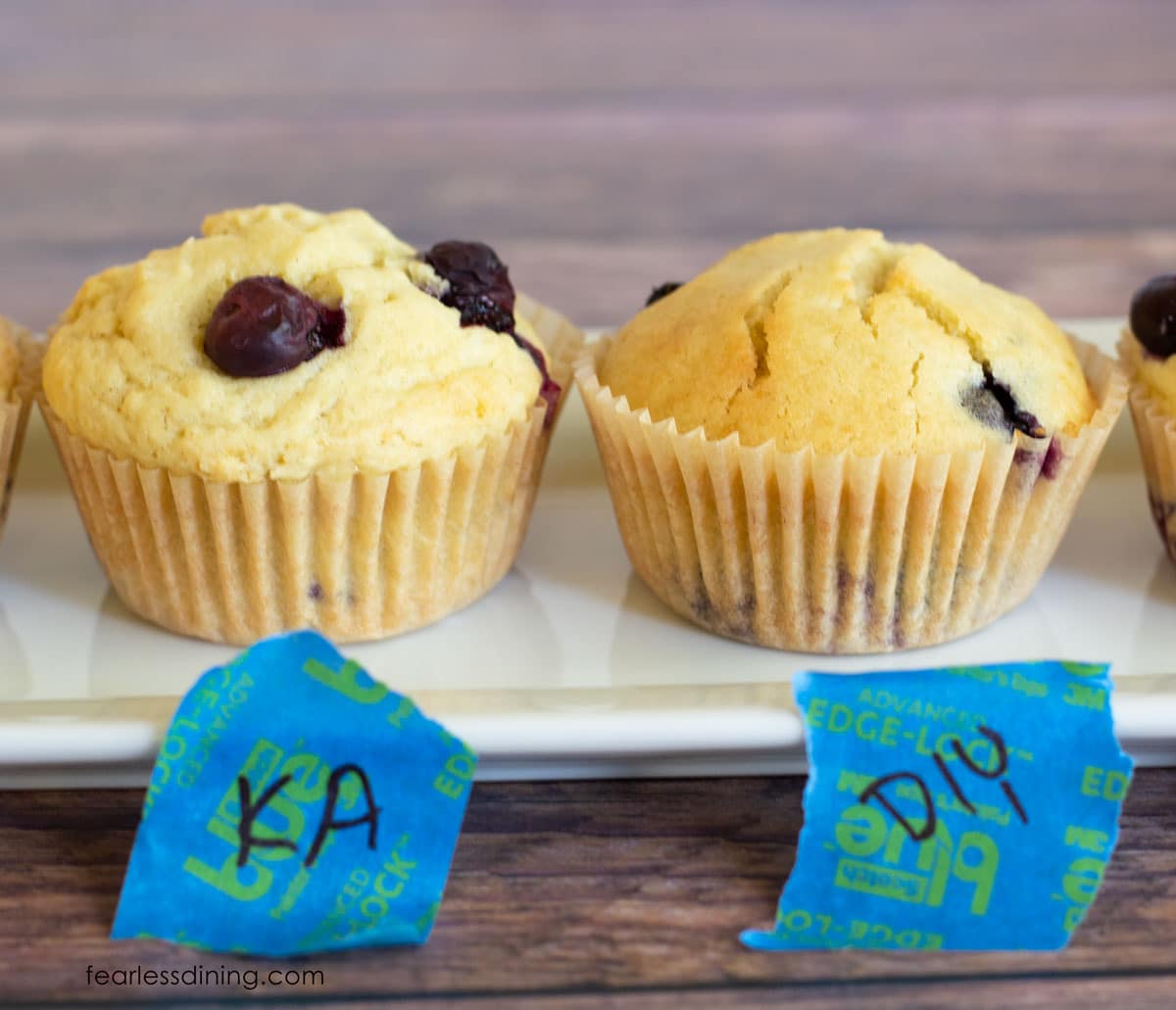
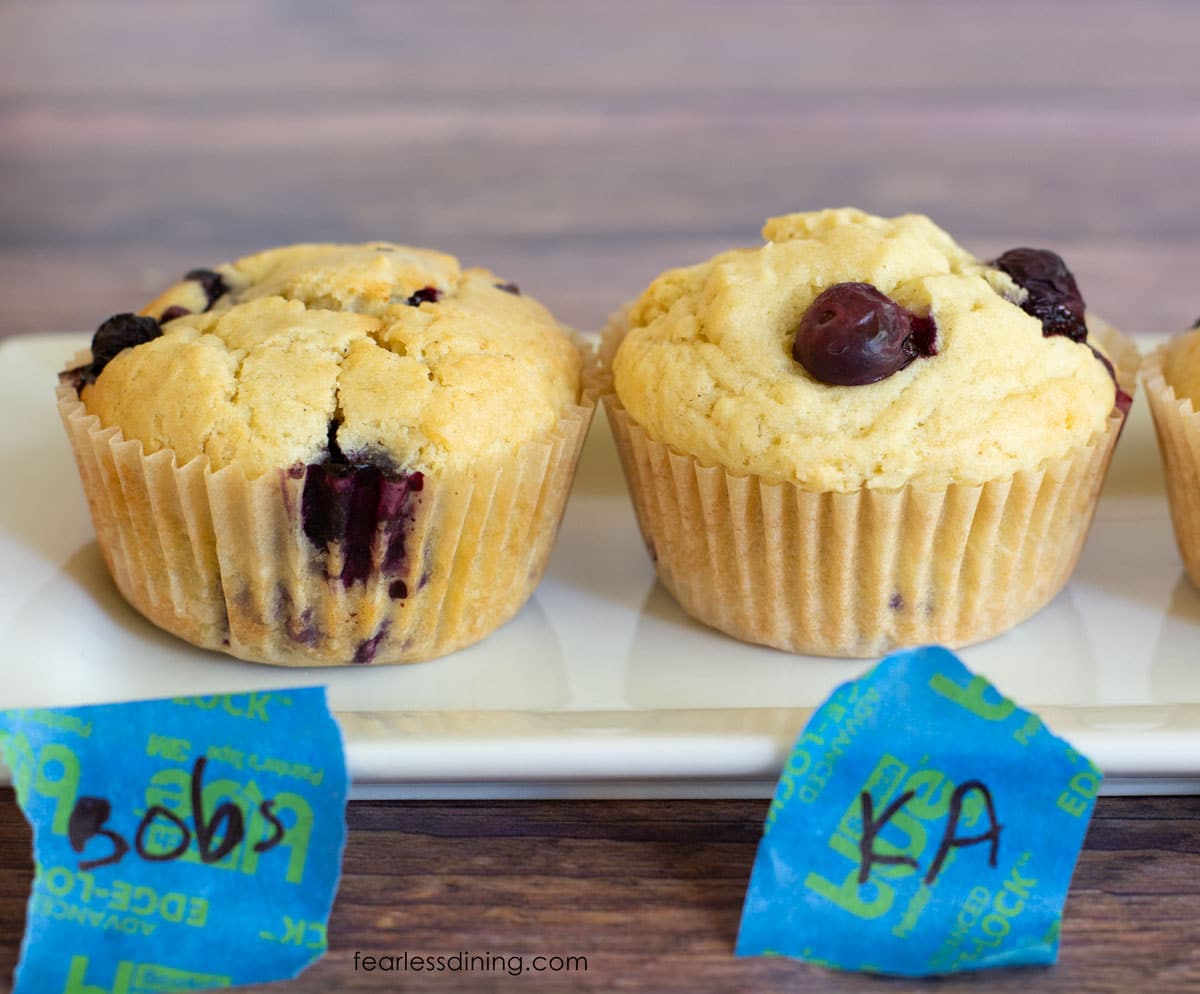
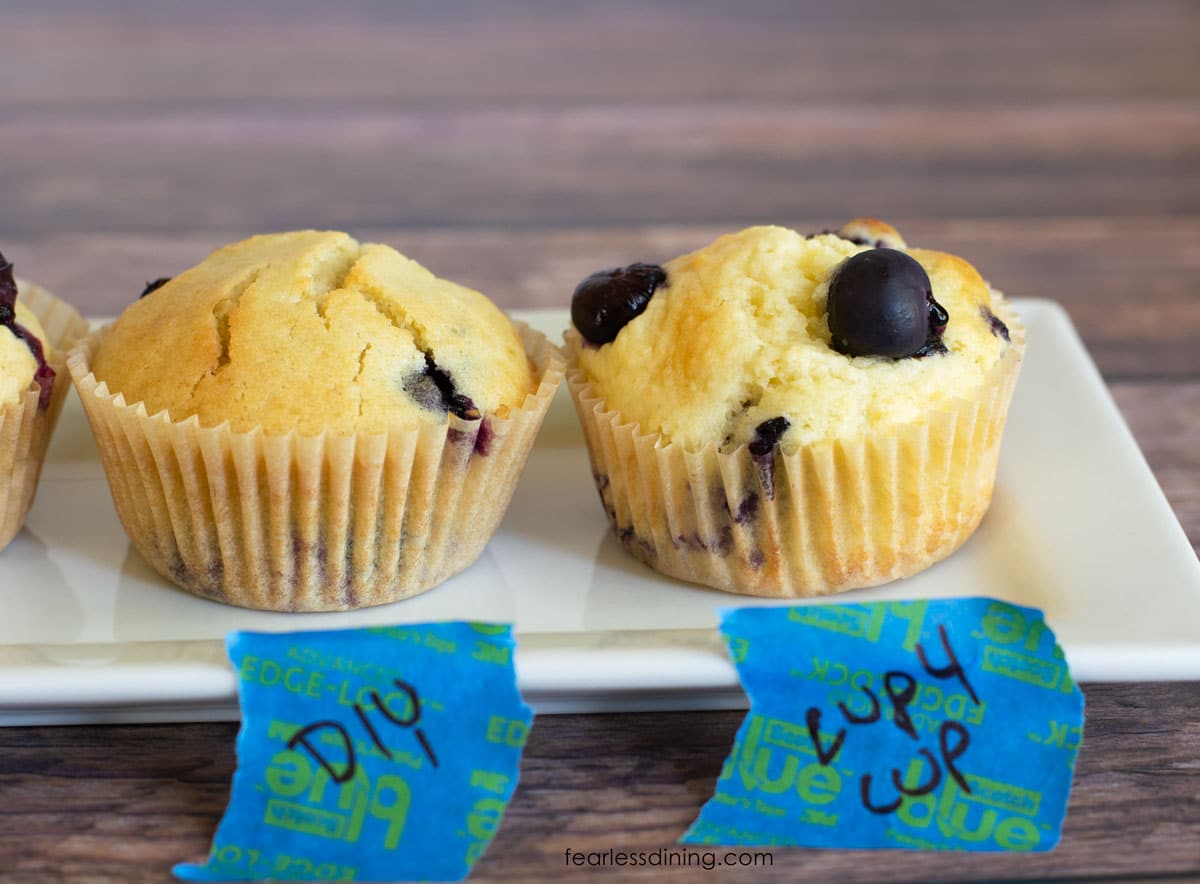
Comparison Photos:
Here are some fun side-by-side comparison muffin photos so you can see the texture and size of the muffins. As I noted above, the Bob’s and my DIY gluten free flour blends could have used more flour. Every gluten-free flour blend is different; you need more flour for some blends.
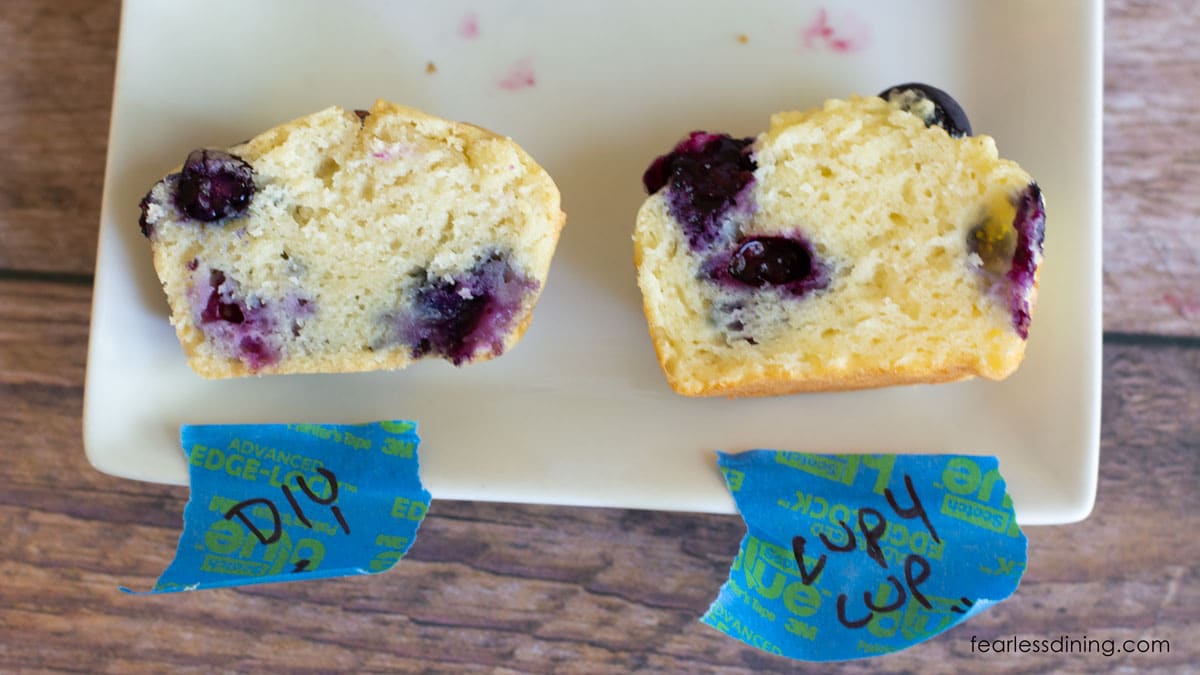
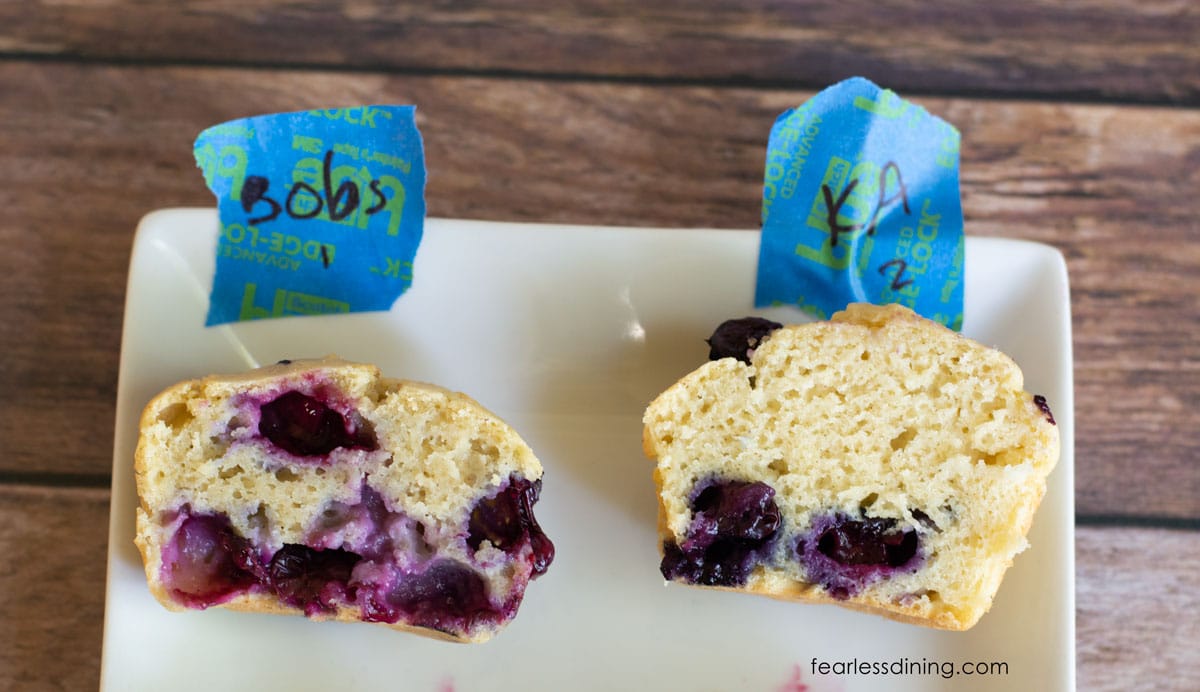
These side-by-side interior photos of the muffins show their fluffiness and texture. The KA and Cup4Cup rose the best and stayed more fluffy than the other two blends, but this could have been affected by the Bob’s and DIY’s runnier batter.
Storage:
Store leftover muffins in an airtight container so they don’t dry out. I like to store mine in the refrigerator, especially during warmer months. If you don’t eat them in a few days, I recommend storing them in a freezer-safe zipper bag.
If you want to make a muffin in 3 minutes, try this fluffy Gluten Free Mug Muffin recipe.
Frequently Asked Questions:
Yes, you can use frozen blueberries. You will need to thaw them and drain the juice. Note that using frozen blueberries will change the color of your muffins.
I haven’t tested this recipe with an egg replacer, but I successfully used Bob’s Red Mill Egg Replacer in this vegan muffin recipe. The recipes are similar enough that I suspect this egg replacer would work well in this recipe.
To check if the muffins are finished baking, insert a toothpick in the middle. The muffins are done baking if it comes back with no crumbs or batter. If you see crumbs or batter, they must bake a little longer.
You may also love this Gluten Free Peach Muffins recipe. You can use fresh, frozen, or canned peaches in this recipe.
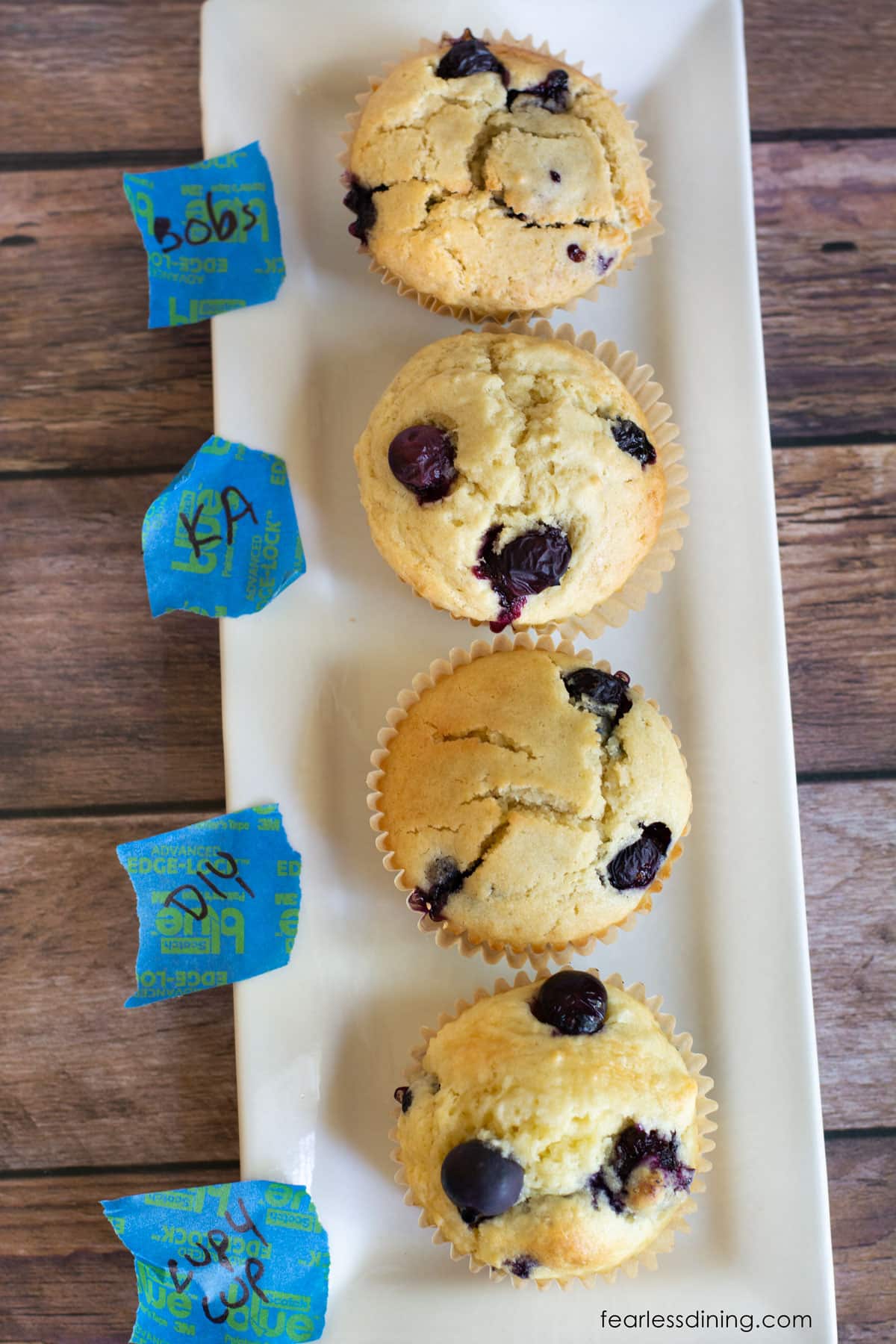
More Gluten Free Muffin Recipes:
- Gluten Free Lemon Poppy Seed Muffins – The lemon flavor in these muffins is delicious!
- Gluten Free Zucchini Muffins – Even zucchini haters will love this healthier muffin!
- Gluten Free Cream Cheese Pumpkin Muffins – These are so good; why would you only eat them in the fall?
- Gluten Free Banana Oatmeal Muffins – This muffin makes a great grab-and-go breakfast.
Love This Recipe?
If you made and enjoyed this recipe, I would be incredibly grateful if you could leave a comment below. Please include which flour blend you used. This will help others know this recipe is delicious. Thank you!

The Best Gluten Free Muffins
Ingredients
Method
- Add the f1 ½ cups gluten free flour blend, ½ cup cane sugar, 1 ½ teaspoons baking powder, and ⅛ teaspoon salt to a large mixing bowl and use a wire whisk to blend it.
- In a smaller microwave-safe bowl, partially melt your 6 tablespoons unsalted butter for 30 seconds in the microwave oven. Add the 2 large eggs, 1 cup milk or non-dairy milk, and v1 teaspoon pure vanilla extract and whisk. Add the ¾ cup blueberries or another fruit.
- Pour the wet ingredients into the dry ingredients.
- Mix until they are just barely mixed. This is really important. Don't overmix your batter or your muffins will turn out dense. Do not use a stand mixer or electric mixer.
- Line your muffin pan with parchment paper-lined muffin liners. Fill each 3/4 full of batter.
- Preheat the oven to 425º F.
- Let the muffin batter sit for 10 minutes so the rice flour can soften.
- Bake the muffins for 5 minutes at 425º F, then turn the temperature down to 350º F. Bake for 20 minutes or until done. The actual baking time can vary depending on your pan size and if you use a silicone vs. metal pan. I noted Cup4Cup did bake a few minutes quicker than the other blends.
- Remove the muffins from the oven and move them to a cooling rack. The muffins may fall a little as they cool.
Nutrition
Notes
- I tested flour blends that are easy to find in most grocery stores, including King Arthur Measure for Measure, Bob’s Red Mill 1:1, Cup4Cup, and my DIY Gluten Free Flour Blend (gum-free.)
- Here are the gram measurements for each flour: KA 120.1 grams, Bob’s 122 grams, Cup4Cup 115.3 grams, DIY Blend 122.5 grams.
- You can add any fruit you like to this muffin recipe.
- Store in an airtight container for up to 2 days on the counter (except summer), 4 days in the refrigerator, or freeze them in a freezer-safe zip-style bag
- Bob’s Red Mill 1:1 – Bob’s Red Mill 1:1 was good, though the muffins were slightly gummier/chewier than the others. I think this is due to the batter being runnier than the others. I recommend adding 2-3 tablespoons of additional flour if you use this blend.
- King Arthur Measure for Measure – The King Arthur muffins rose nicely and were one of our favorites. I do not recommend any changes to the recipe. Note they had a slight grittiness. To fix this, let the batter sit before baking for 10 minutes so the rice flour can soften more. These muffins rose well and were almost cake-like in fluffiness.
- Cup4Cup – Cup4Cup was also a great blend for this muffin recipe. Note for those who are dairy-free; this blend contains dried milk powder. The Cup4Cup muffins were a little more golden in color due to the dried milk powder in the blend. These muffins rose well and stayed almost cake-like in fluffiness.
- My DIY Gluten Free Flour Blend – My blend performed well and had good taste and texture, but I feel the muffins would have turned out even better if an additional 2-3 tablespoons of flour had been added.
Nutritional Disclaimer
Nutritional information is an estimate provided to you as a courtesy. You should calculate the actual nutritional information with the products and brands you are using with your preferred nutritional calculator.
Tried this recipe?
Let us know how it was!
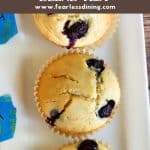
Another huge Canadian fan Sandi. You are my go to. An easy muffin question for you. Could I make the batter the day before and refrigerate it overnight in order to bake fresh muffins in the morning? I am adapting our fave orange cranberry muffin to be GF.
Thank you
Midge
Hi Midge, thank you so much for your kind words. As for the muffin batter, it should be fine to refrigerate overnight and bake it the next day.
I just made this in an 8 inch square pan at 350 for 30 minutes. Instead of blueberries, I stirred in about a cup of blueberry compote. It is absolutely delicious!! I’ll be making again!
Blueberry compote sounds amazing, Joyce! Thank you for the yummy idea!
Hi , I just tried this recipe with a gluten free mix from Bulk Barn and was wondering if you needed to grease the parchment paper muffin liners? Mine all stuck to the paper liners sadly.
Hi Ruth, I have not heard of that flour, but if it stuck like that, my guess is there is a lot of starch in the blend you used. Is this a brand for sale in the U.S.A.? I would add a little more flour next time and use parchment paper muffin liners.
Could I add a cup of oats to this mixture as well or would they come out as chewy or raw?
Hi Cori, I haven’t tested adding oats. If you are looking for an awesome oatmeal muffin, use this recipe: https://www.fearlessdining.com/gluten-free-oatmeal-muffins/